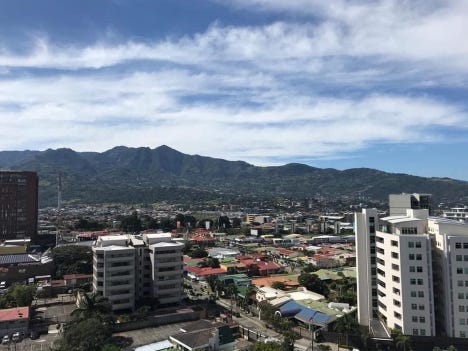Issue 36: What is Costa Rica's secret?
Thanks to a history of investment in social security and public health and a government that has worked hard to build trust, Costa Rica's pandemic response is a model for the world
Todays’s briefing is by Erika Moyer (EM), a graduate student at the Max Bell School of Public Policy. Her work experience includes three years in Inter-American Affairs at the International Committee of the Red Cross, followed by environmental policy in Latin America at the Natural Resources Defense Council. She is riding out the pandemic in Montreal.

COSTA RICA WAS THE FIRST CENTRAL AMERICAN COUNTRY to report a case of COVID-19, and has since become the most successful country in the Americas to control the virus. Costa Rica has had only 815 cases with no community spread, a low mortality rate (only 8 deaths) and currently has more recovered cases than active ones.
What’s the secret?
Costa Rica’s successful response is rooted in its history. In 1948, rather than investing in arms and soldiers, President José Figueres Ferrer abolished its army and invested heavily in education and social security. Costa Rica’s universal health care system guarantees free access to COVID-19 tests and treatments. For a population of 5 million people, there are 29 hospitals spread throughout the country and a network of public healthcare clinics in almost every neighbourhood. This network has focused on preventing community spread by monitoring each positive COVID-19 case. In addition to the hospitals, the Social Security Fund has converted a rehabilitation centre in San José into an 88-bed hospital dedicated exclusively to COVID-19 patients.
Compared to other Central American countries (Panama, for example, has over 8000 cases) the government acted swiftly to curtail the pandemic. Ten days after the first confirmed case, the country declared a state of emergency and closed its borders. The Costa Rican Constitution prevents the government from implementing a curfew, but it has acted to limit road traffic at night and in dense areas, and closed public gathering space and private businesses like gyms, bars, and movie theatres. Most restaurants, shops, and small businesses have been allowed to operate with a reduced capacity. As for support, the government announced a USD $1.5 billion economic package, which includes loans and assistance for small and medium business. Under the government’s Plan Proteger, Costa Ricans whose jobs have been affected by the pandemic can receive a monthly bonus of up to USD $220 for three months.
Daily press briefings by the Minister of Health, Daniel Salas, and the President of the Social Security Administration, Roman Macaya, have been the main outlets for public health information. Every day at 1 pm,, the Minister of Health, an epidemiologist himself, addresses the public and responds to questions from the accredited press. The President of Costa Rica, Carlos Alvarado, often participates in the briefings, urging the population to respect the government’s measures and to stay at home. According to the Minister of Health, Costa Ricans understand the dangers of the current pandemic to a great degree; they are complying with government confinement and sanitation measures. The briefings have boosted public trust within the Costa Rican community and have improved the public perception of President Alvarado.
Costa Rica is putting science first by pioneering three plasma-based strategies to treat COVID-19. The University of Costa Rica’s Clodomiro Picado Institute, a world-renowned institution specializing in the development of snake antivenoms, is applying this technique to create a serum from plasma donated by recovered patients to treat the virus. In addition, the National Center for Biotechnological Innovations is conducting research to develop its own tests for detecting the virus. The Costa Rican Institute for Research and Teaching in Nutrition and Health has managed for the first time in the country’s history to sequence the genome of SARS COV-2, which causes COVID-19. This advance will allow scientists to learn whether the virus mutates over time and will generate information that can be useful for developing vaccines and for learning the transmission routes in the country.
As a result of its success to date, Costa Rica has begun to slowly lift confinement restrictions. Theatres, gyms, and hair salons have reopened with reduced hours and social distancing measures in place. The borders remain closed to all non-residents, including tourists. The Costa Rican economy relies heavily on tourism: the country receives 2.6 million visitors per year, and tourism accounts for 8 percent of the country’s GDP. The hit to tourism will have massive impacts in the months and years to come. President Alvarado and other public figures have started urging tourists not to cancel but rather to postpone their visit.
Costa Rica’s investment in social security and strong network of community clinics is one of the reasons the country’s response to the pandemic has been successful to date. What differentiates Costa Rica from the rest of Central America is not only its prompt response, but also its collaborative approach with the science and public health communities. Despite being a small country with only 5 million people, Costa Rica is making history. If it continues its successful response against the virus, countries near and far will be able to learn from its example. (EM)

Watch: For three days only, YouTube is broadcasting a classic Prince concert from the 1985 Purple Rain tour
Listen: 60 Songs that Saved My Life — a curated list by Bono
Make: #stonerfoodoftheapocalypse: One Bowl Mascarpone Brownies
Tweetstorm: Men of Middle Earth as bad ex-boyfriends
___
Policy for Pandemics is produced and edited by Andrew Potter and co-edited by Charlotte Reboul and Paisley Sim (bios here) If you have any feedback or would like to contribute to this newsletter, please send an email to andrew2.potter@mcgill.ca



